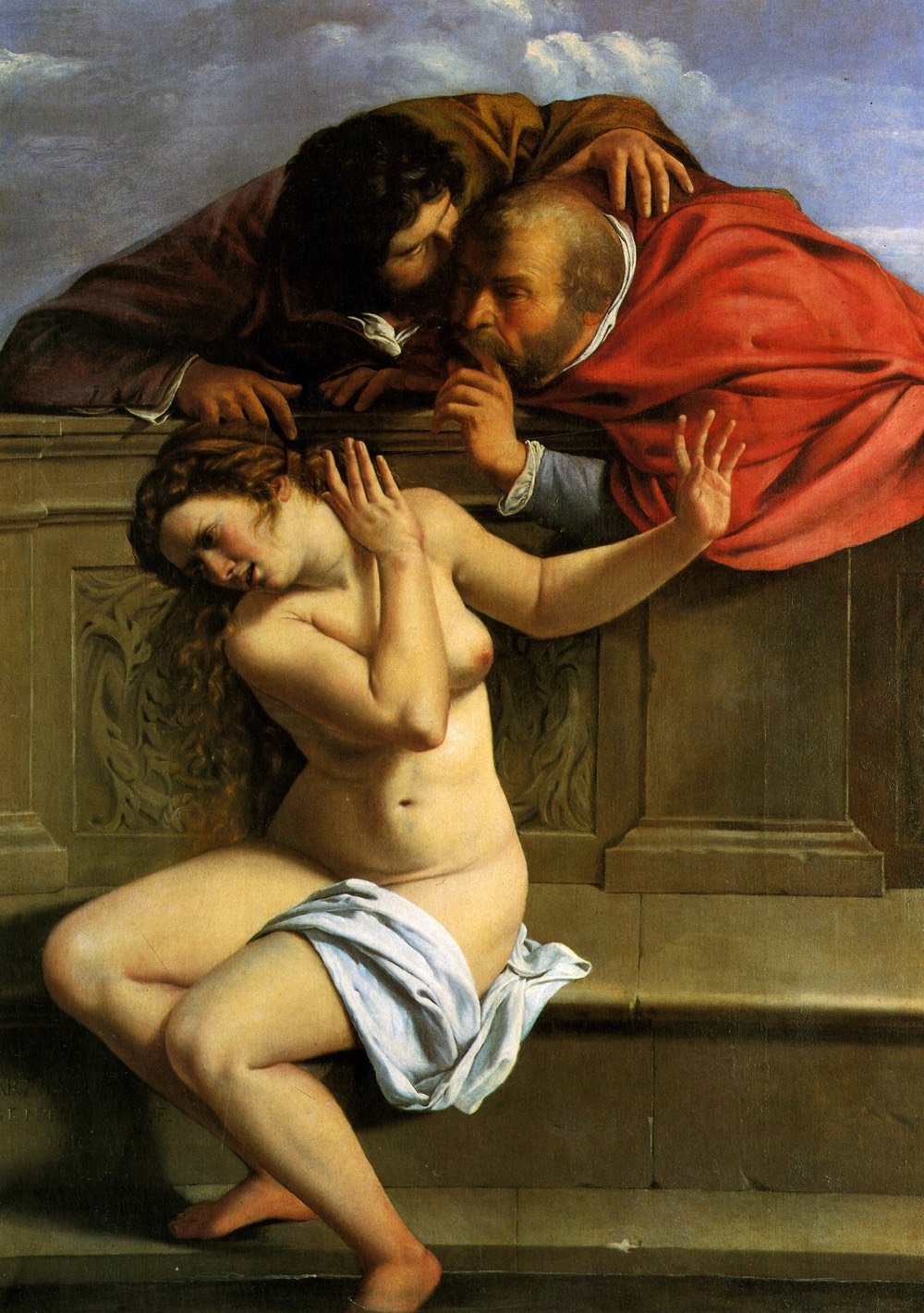Artemisia Gentileschi, Praised and Reappraised

For the New Yorker, Rebecca Mead writes about the 17th-century Italian painter Artemisia Gentileschi, whose work has been growing in stature and popularity in recent years.
Increasingly, Artemisia is celebrated less for her handling of private trauma than for her adept management of her public persona. Throughout her career, she demonstrated a sophisticated comprehension of the way her unusual status as a woman added to the value of her paintings. On a formal level, her representation of herself in the guise of different characters and genders prefigures such postmodern artists as Cindy Sherman. Unlike Sherman, however, Artemisia had few female peers. She was not the only woman working as an artist during the early seventeenth century: a slightly older contemporary was the northern-Italian portraitist Fede Galizia, born in 1578, whose father, like Artemisia’s, was also a painter. But Artemisia must often have felt singular. In a series of letters written to one of her most important patrons, the collector Antonio Ruffo, she wittily referred to her gender: “A woman’s name raises doubts until her work is seen,” and, regarding a work in progress, “I will show Your Illustrious Lordship what a woman can do.” In 2001, the scholar Elizabeth Cropper wrote, “We will never understand Artemisia Gentileschi as a painter if we cannot accept that she was not supposed to be a painter at all, and that her own sense of herself — not to mention others’ views of her — as an independent woman, as a marvel, a stupor mundi, as worthy of immortal fame and historical celebration, was entirely justified.” On art-adjacent blogs, Artemisia’s strength and occasionally obnoxious self-assurance are held forth as her most essential qualities. She has become, as the Internet term of approval has it, a badass bitch.
An exhibition of Gentileschi’s work is set to open early next month at the National Gallery in London and is getting rave reviews. Man, I’d love to go see this in person!
BTW, when reading Mead’s piece, I kept stopping to search for the art she referenced and I recommend you do the same. It’s a) frustrating that the New Yorker doesn’t use hyperlinks for this purpose in the online version and b) still wondrous after all these years that this fantastic art is available to view online with a few quick clicks and keystrokes. Imagine reading a piece like this in 1989 and wanting to look at the art - it would take a trip to the library and then probably hours of searching.
Oh hell, I’ll just do this quick…here’s every painting referenced in Mead’s piece:
- “Susanna and the Elders”, Tintoretto: “…he portrayed Susanna as serene and abstracted, towelling a raised foot and regarding herself in a mirror, unaware of a bald man who is concealed behind a rose trellis and peering between her parted thighs.”
- “Susanna and the Elders”, Peter Paul Rubens: “…Susanna is shown reaching for a shawl, realizing with horror that she has been exposed to two leering men.”
- “Susannah and the Elders”, Ludovico Carracci: “Sometimes the violence threatened against Susanna is indicated in the tableau…”
- “Susanna and the Elders” (1610), Artemisia Gentileschi (pictured above): “Her head and her body torque away from the onlookers as she raises a hand toward them, in what looks like ineffectual self-defense.”
- “Self-Portrait as St. Catherine of Alexandria”, Artemisia Gentileschi: “…the subject gazes at the viewer, her brow dimpled in concentration, while wearing a gauzy turban and other finery.”
- “Judith and Her Maidservant with the Head of Holofernes”, Artemisia Gentileschi: “…offers a masterly execution of the technique, with its subjects illuminated, mid-action, by raking lamplight.”
- “Judith Beheading Holofernes”, Artemisia Gentileschi: “It shows the Biblical heroine with her sleeves rolled up over muscular arms, her mouth set, deftly butchering the Assyrian general.”
- “Crucifixion of Saint Peter”, Caravaggio: “…the elderly martyr is being raised, upside down, on a cross…”
- “The Conversion on the Way to Damascus”, Caravaggio: “…a young, muscled St. Paul is sprawled on the ground after receiving a heavenly vision.”
- “Young Woman with a Violin (Saint Cecilia)”, Orazio Gentileschi: “…shows a musician with a cleft chin, a rounded cheek, and an alert expression.”
- “David and Goliath”, Artemisia Gentileschi: “…a painting that shows David sitting triumphantly next to Goliath’s severed head…”
- “Cleopatra”, Artemisia Gentileschi: “…the ‘uncompromising sensuality’ of the recumbent nude…”
- “Danaë”, Artemisia Gentileschi: “Creases around the figure’s armpits and swells in the stomach reveal an awareness of the way a woman’s flesh settles and subsides.”
- “Danaë and the Shower of Gold”, Orazio Gentileschi: “…features bed linens so realistic that the viewer feels she could climb between them, but the princess’s breasts defy gravity with an almost comical perkiness.”
- “Self-Portrait as a Lute Player”, Artemisia Gentileschi: “…the delicacy and articulation of the hands, shown mid-strum on the instrument.”
- “Allegory of Inclination”, Artemisia Gentileschi: “…a female nude sitting on a tuft of cloud.”
- “Judith Slaying Holofernes”, Artemisia Gentileschi: “…a maidservant, Abra, forcefully holds Holofernes down while Judith confidently hacks away at his neck.”
- “Judith Beheading Holofernes”, Caravaggio: “She hardly seems to have the oomph required for decapitation.”
- “The Birth of Saint John the Baptist”, Artemisia Gentileschi: “…Artemisia’s version underlines her intimacy with the dynamics of the birthing room.”
- “Madonna and Child”, Artemisia Gentileschi: “Mary swoons, eyes closed, as the infant Jesus reaches for her cheek, his eyes locked on her face with palpably needy attachment.”
- “Susanna and the Elders” (1652), Artemisia Gentileschi: “…this Susanna draws the elders’ attention away from her body not by blocking their gaze but by meeting it with her own — staring at them just as they stare at her, and obliging them to acknowledge her as a human being.”
- “Mary Magdalene in Ecstasy”, Artemisia Gentileschi: “…her slight smile seems labile, indicating that Artemisia understood a woman’s sensuality from the inside out.”
- “Self-Portrait as the Allegory of Painting”, Artemisia Gentileschi: “Rather than looking out of the frame, as is typical with self-portraits, the figure is looking at a prepared canvas, with a raised brush in one hand and a palette in the other.”
Viewing, comparing, and contrasting these paintings is a great little tour through one brief moment in the long history of art. Have fun!






Stay Connected